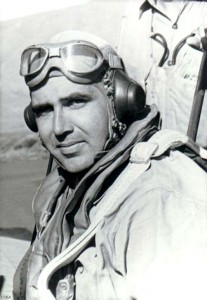
World War II produced many heroes.
One such man was a Lieutenant Commander Butch O’Hare. He was a fighter pilot assigned to the aircraft carrier Lexington in the South Pacific.
One day his entire squadron was sent on a mission. After he was airborne, he looked at his fuel gauge and realized that someone had forgotten to top off his fuel tank. He would not have enough fuel to complete his mission and get back to his ship. His flight leader ordered him to return to the carrier. Reluctantly he dropped out of formation and headed back to the fleet.
As he was returning to the mother ship, he saw something that turned his blood cold. A squadron of Japanese bombers was speeding their way toward the American fleet. The American fighters were gone on a sortie and the fleet was all but defenceless. He couldn’t reach his squadron and bring them back in time to save the fleet. Nor could he warn the fleet of the approaching danger.
There was only one thing to do. He must somehow divert them from the fleet. Laying aside all thoughts of personal safety, he dove directly into the formation of the Japanese planes. Wing-mounted 50 calibres blazed as he charged in, attacking one surprised enemy plane and then another. Butch weaved in and out of the now broken formation and fired at as many planes as possible until finally all his ammunition was spent.
Undaunted, he continued the assault. He dove at the planes, trying to at least clip off a wing or tail, in hopes of damaging as many enemy planes as possible and rendering them unfit to fly. He was desperate to do anything he could to keep them from reaching the American ships. Finally, the exasperated Japanese squadron took off in another direction.
Deeply relieved, Butch O’Hare and his tattered fighter limped back to the carrier. Upon arrival he reported in and related the event surrounding his return. The film from the camera mounted on his plane told the tale. It showed the extent of Butch’s daring attempt to protect his fleet. He had destroyed five enemy bombers. That was on February 20, 1942, and for that action he became the Navy’s first Ace of WWII and the first Naval Aviator to win the Congressional Medal of Honor.
A year later he was killed in aerial combat at the age of 29. His home town would not allow the memory of that heroic action die. And today, O’Hare Airport in Chicago is named in tribute to the courage of this great man. So the next time you’re in O’Hare, visit his memorial with his statue and Medal of Honor. It is located between terminal 1 and 2.
(Sourced from the Internet)





